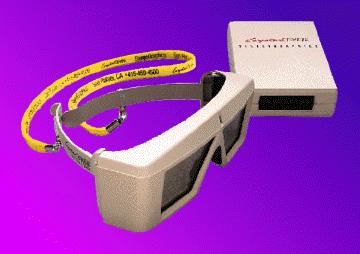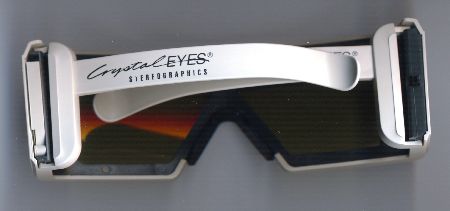
The unofficial
StereoGraphics
CrystalEYES CE2 page
Quick info:
The CrystalEyes 2 by StereoGraphics
are synonymous for professional glasses. Whenever you see pros at work
they wear CrystalEyes. The glasses itself are the best I've ever worn.
The hi-quality LCD-panels are gigantic and make them the right choice for
21" monitors and even large projection based VR-systems. Comfort is great
and the CrystalEyes fit over any prescribed glasses.
There are several controllers to choose
from. The 'ENT'-controller has a VESA mini-DIN-3 jack. The 'EPC2'-controller
has a sync-doubler which is controlled manually. Apart from that the EPC2
also syncs to interlace and page-flipping modes, but only as long as SimulEyes
White Line Code is present at the bottom of the screen. This is a huge
drawback in terms of compatibility. There is no line-blanker mode.
The sync-doubler which handles the popular
above-below splitscreen 3D format enables the CE2-glasses + EPC2 to work
with a large range of professional applications, as well as with the Wicked3D
eyeSCREAM drivers.
CrystalEyes2 usually don't work with
ASUS or ELSA drivers. It should be possible however to connect the CrystalEyes
ENT-emitter to a 'Revelator-type' VGA-to-DIN-3 cable and make use of the
Revelator drivers. Another option would be to combine the CrystalEyes2
glasses with the NuVision 60GX-NSR controller/emitter-unit.
The verdict:
The CrystalEyes 2 is an outstanding
shutterglasses system. The glasses itself are the best money can buy. The
controllers should be more flexible though.
The biggest problem is the price. At
$795 for the glasses plus $400 for the sync-douber-emitter or $200 for
the DIN-3-emitter any shutter-system would be overpriced - no matter how
good.
But... the CrystalEyes are used in
million-Dollar projects by organizations such as NASA or General Motors.
No professional cares about the price whether it's just $10 or a $1000
and that's what StereoGraphics counts on. Industrial goods are always expensive.
What's not taken into consideration
here is the amount of support which is granted to professional users by
StereoGraphics and its partners. I hope it's good, but I can't testify
on that.
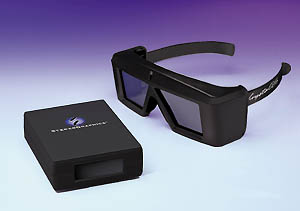
CrystalEyes3
Update: In
1st half of 2000 StereoGraphics introduced the CrystalEyes3, which is very
similar to it's predecessor.
The controller technology and connectors
remained the same. IR code should also be the same.
Differences: slightly lighter, slightly
more rugged, longer battery life, battery-indicator-LED.
This review isn't
intended for beginners. Please consult the Basics
and FAQ pages if questions arise.
Related Links:
VRT GmbH,
Germany
StereoGraphics
NuVision 60GX review
Wicked3D review
Wicked3D
This page was innitially released on Sept. 25, 1999,
last update: August 19, 2000
Pro
|
Con
|
Glasses
|
Glasses
|
+ extremely large
& clear panels
+ very comfortable with
and w/o prescribed glasses
+ shutters are off and clear
in stand-by mode (opposed to 60GX)
+ good nose piece (superior
to 60GX)
+ headtracking version (CrystalEyes
VR) available (the CE-VR seems to have vanished from the SG-website, I
hope it's not discontinued)
+ activated by bows
|
|
ENT-controller
|
ENT-controller
|
+ VESA compliant
mini-DIN-3 stereo connector
+ connects to DIN 3, 5,
7, DB9, 3.5 mm (ask for proper adaptor)
|
- user has to decide
between ENT and EPC2 controller --> expensive
(no 2-in-1 as 60GX-NSR)
- no reverse button (not
neccessary)
|
EPC2-controller
|
EPC2-controller
|
+ supports above-below
with manual control
+ suppors interlace and
page-flipping (with WLC only)
+ WLC (white line code)
provides automatic control and prevents stereo-reverse conditions
+ also covers the functionality
of the ENT-controller (with homemade cable)
|
- no page-flipping
or interlace support if WLC is not present
- emitter & controller
in one box
- switches hard to reach
on the back of the IR-emitter
- fluctuations in sync-doubled
signal (I had problems with my monitor- Iiyama which is very vulnerable
to fluctuations, screen went black from time to time due to sync-problems,
I had no probs with the H3D, 3DTV and 60GX sync-doublers
- doesn't support ELSA-
or ASUS-drivers, since they lack WLC - of course
- no line-blanker
- external power supply
only
- VGA-dongle may block other
connectors on graphics board (for example: Voodoo2 VGA-in, ELSA Erazor
III video cable)
|
Misc
|
Misc
|
+ optional long
range IR-emitter available
+ high prestige: used by
NASA and other top organizations and companies
|
- expensive
|
The ENT controller/emitter (VESA miniDIN-3)
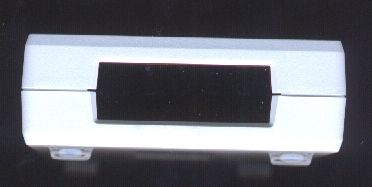
ENT front
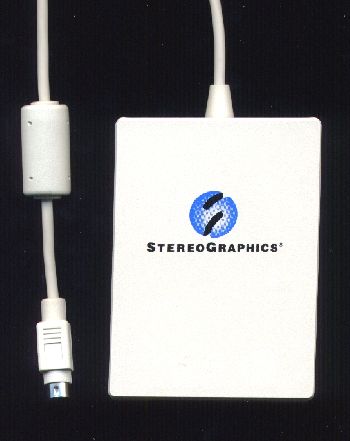
The ENT (emitter for Windows NT) with fixed cable and VESA mini-DIN-3
stereo jack. No buttons, no external power required.
The ENT controller just plugs into a stereo ready workstation or hi-end
gfx-board with mini-DIN-3 stereo connector. There are adaptors for some
other stereo connectors available, such as a DIN-3 to DIN-9 adaptor.
The ENT has no manual controls whatsoever and even gets it's power
through the DIN-3 cable which is fixed to the box.
The EPC2 controller/emitter
The EPC2 controller can be connected to any standard VGA-connector via
a VGA-pass-through cable. By using the MODE switch it can be manually set
to sync-doubler mode which transfers any above-below splitscreen image
into a frame-sequential format. The refresh rate is doubled in the process.
This eliminates flicker in all cases, but may cause trouble on some monitors.
This technology doesn't require any driver software and works for any operating
system. The only thing you need is some above-below stereo format software,
such as professional applications or Wicked3D powered stereo games.
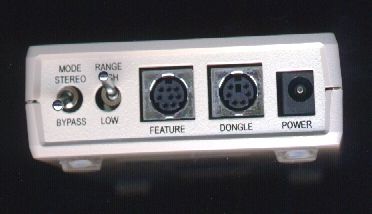
The back of the EPC2 (emitter for PC 2) sync-doubler controller/emitter
The MODE switch has 3 positions: 1) Bypass (off), 2) WLC autosync 3)
sync doubling. The emitter range can be set to high and low. The low setting
is important if more than one system is used in the same room. The same
feature can also be found on the H3D/Wicked3D emitters.
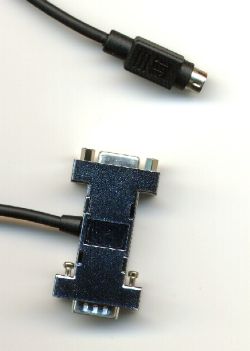
The VGA-pass-through dongle of the EPC2.
The EPC2 also reacts to interlace or page-flipping modes as long as
White Line Code is present. Such functions require a gfx-chipset-specific
driver software.
There is no interlace or page-flipping driver delivered with the glasses.
An utility which adds White Line Code is also missing. The best driver
for the EPC2 would be 3DWin 2.3 by i-Art which supports many and also provides
WLC. 3DWin is available as a bundle with i-Art and VR-Joy glasses and as
part of the i-Art VRShow! multimedia software package. Another option would
be to search the web for old SimulEyes windows drivers, which are hopelessly
outdated by now.
The EPC2 also works on a DIN-3 output by using a modified
cable.
Power
The EPC2 controller is powered by an external adaptor.
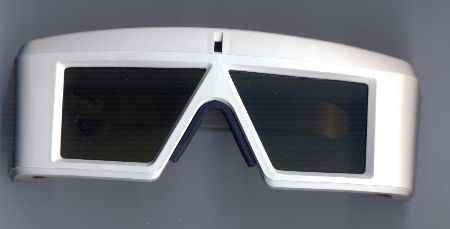
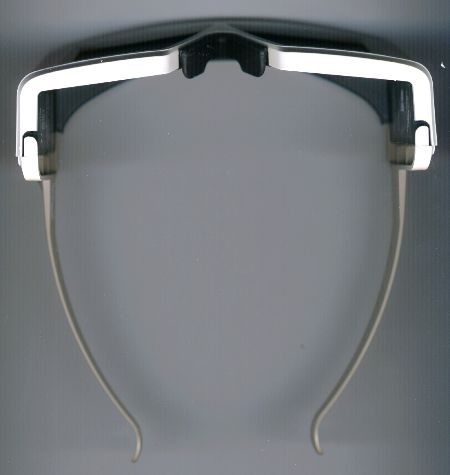
There's not much to say about the glasses. They're just great. The panels
are clear and huge. The resulting field of view is more than satisfying.
The comfort is outstanding. The excellent panels can't do anything about
the usual ghosting, but at least they deliver a bright image, better than
the dark, colored glasses of H3D/eyeSCREAM or CrystalEyes-Wired.
The CE2 glasses are activated by opening the bows. An idea which was
later adapted by other developers, such as H3D. Although the stability
of the construction seems to be above average, the CE2 isn't unbreakable.
One unlucky plunge and the bows may brake off from the frame. At 795 $
you'd better be careful.
Please check the X-RAY Lab for a weight&size
comparison of various shutterglasses.


The over-under split-screen stereo format handled by the EPC-2
controller is very popular in professional applications. It's also used
in the Metabyte Wicked3D drivers for consumers. The EPC-2 also handles
some older drivers, applications and games written for the late SimulEyes
consumer glasses (white line code). The latest interlace driver which supports
white line code is i-Art's 3D-Win.
Check the StereoGraphics software list for professional titles. Look
for programs compatible with 'CrystalEyes'.
The ENT-controller requires special drivers and applications
which utilize page-flipping and trigger the dedicated stereo-connector
of the graphics hardware. Usually a special combination of stereo-ready
hardware, operating system, stereo-ready drivers, applications and plug-ins
is required to get the ENT working.
Check the StereoGraphics software list for professional titles. Look
for programs compatible with 'CrystalEyes-Wired' !!!
Incompatibilities:
None of the StereoGraphics Controllers will work with interlace or page-flipping
drivers which doesn't provide white-line-code.
Examples for INCOMPATIBILITY:
ELSA Direct-3D universal stereo-drivers for consumer VGA-cards (it should
be possible to use the ENT-controller plus a Revelator cable though)
ASUS-Direct3D universal stereo drivers
LCD-BIOS, VR-BIOS
H3D-native titles on Voodoo Rush and Rendition cards






